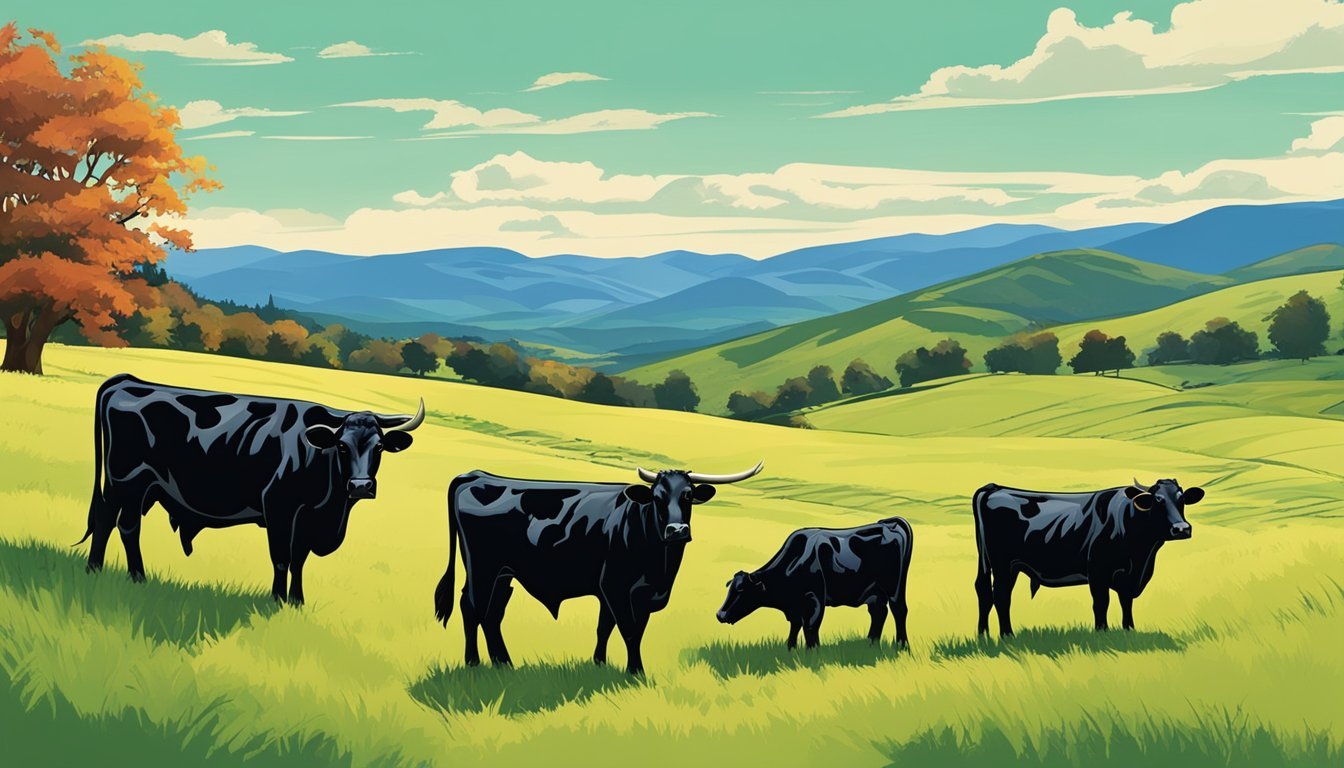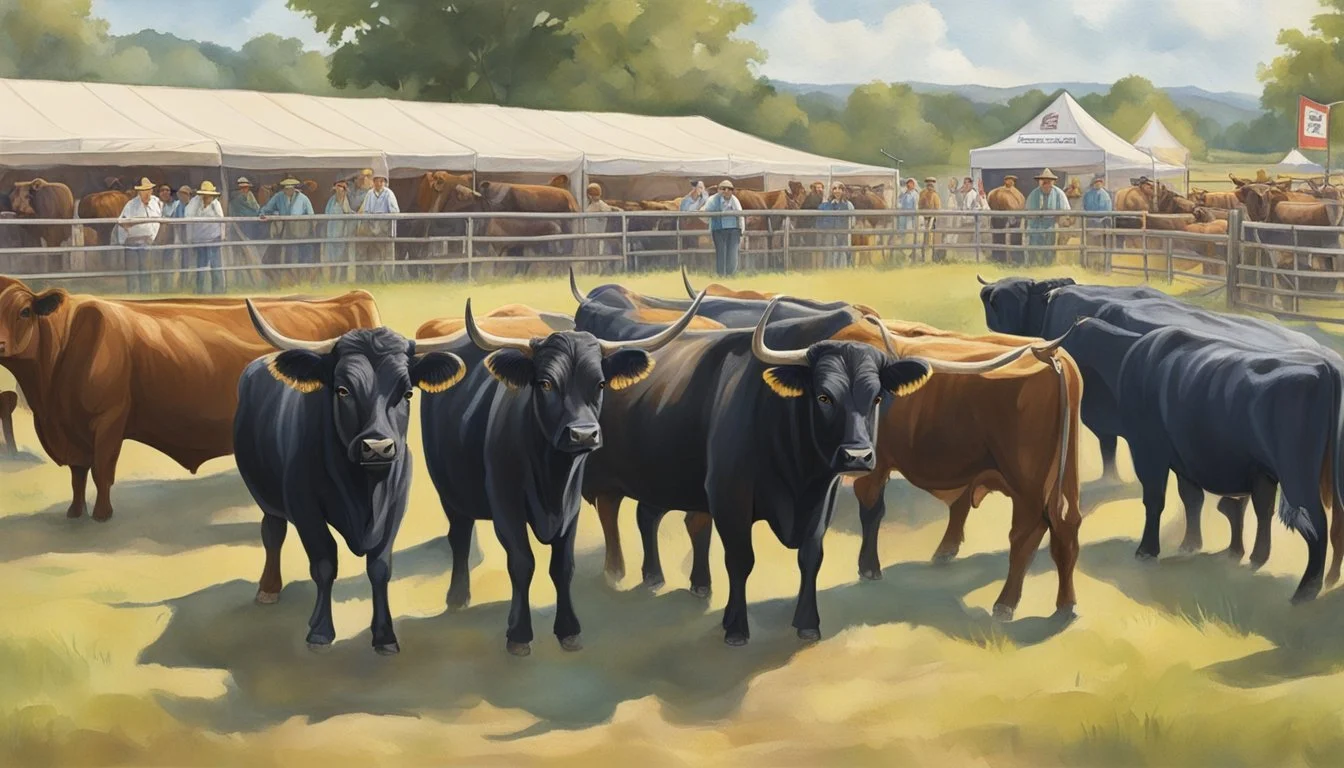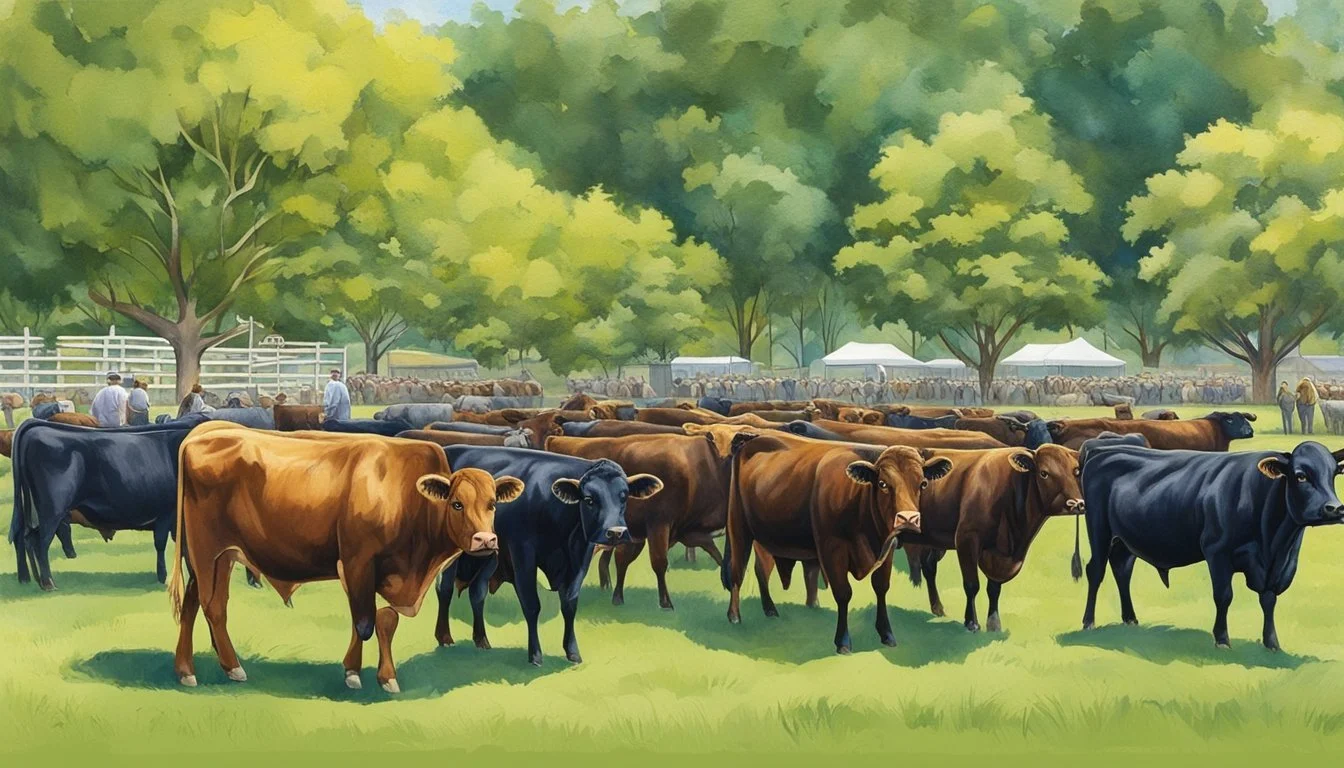Dexter Cattle Shows and Associations
A Guide to Community Engagement
Dexter cattle enthusiasts appreciate the importance of community and shared knowledge in the conservation and promotion of their beloved breed. Whether one is an established breeder or a new admirer, joining the American Dexter Cattle Association (ADCA) opens the door to a network of like-minded individuals dedicated to the breed’s prosperity. Participation in ADCA events is a cornerstone of the community, facilitating connections and providing a platform to showcase the distinctive qualities of Dexter cattle.
Dexter cattle shows are pivotal events where breeders convene to present their best specimens, adhering to established breed standards. These events serve not only as competitions but also as opportunities for learning and exchanging valuable insights into breeding and husbandry practices. Dexter cattle, known for their compact size and versatility, are judged on their conformity to breed characteristics, which cover a wide array of physical and qualitative traits.
The American Dexter Cattle Association plays a critical role in organizing these events and supporting the breed's community through resources, updates on breeding standards, and a range of activities designed to engage all age groups. From regional shows to the annual ADCA Expo, these gatherings are integral for the advancement and recognition of Dexter cattle within the agricultural and livestock communities.
History and Origin of Dexter Cattle
Dexter cattle, a breed with deep roots in Ireland, were developed through careful selection by Mr. Dexter. This breed's history is closely tied to its growth and subsequent importations into America.
Irish Roots and Mr. Dexter
The Dexter breed originated in Ireland, where they were first bred by a smallholder named Mr. Dexter in the early 19th century. He selectively bred animals to create a smaller, more efficient cattle breed, now known as Dexter cattle. Their compact size and hardiness made them suitable for a variety of Irish farmsteads and agrarian applications.
Importations and Growth in America
In America, the first Dexter cattle were imported in the early 20th century. They garnered attention for their adaptability and dual-purpose use for both milk and meat. Over time, various importations helped to establish Dexter cattle as a recognized breed in the United States, with the American Dexter Cattle Association tracing official registrations and pedigrees to maintain the breed's quality and purity.
Characteristics of Dexter Cattle
Dexter cattle are a versatile breed known for their small stature, hardiness, and adaptable temperament. These characteristics make them a popular choice for both experienced and novice farmers.
Physical Traits
Dexter cattle are distinctively small in size compared to other cattle breeds. They demonstrate considerable hardiness, an attribute that supports survival in various weather conditions.
Height: Cows typically stand 36-44 inches tall
Weight: Cows can weigh up to 750 pounds
Body: The breed often exhibits a broad body with well-rounded hindquarters
Color Variations
Dexter cattle have three primary color variations:
Black: The most common color for the Dexter breed
Red: A less common but recognized color
Dun: A pale brown color that occurs in the breed
The breed standard for Dexters typically does not favor excessive white markings.
Breed Temperament
The temperament of Dexter cattle is generally mild and agreeable, which makes handling them relatively easy for breeders. They are known for being:
Docile: Often friendly and easy to manage
Intelligent: Capable of learning and adapting to different farm environments
Due to these traits, Dexters are suited for multiple agricultural settings, from large pastures to smaller farms.
Dexter Cattle as Dual-Purpose Animals
Dexter cattle are often celebrated for their versatility as a dual-purpose breed, providing both high-quality milk and beef. They are known for their high fertility and robustness, making them a valuable addition to farms prioritizing both dairy and meat production.
Milk Production
Dexter cattle's milk is rich in butterfat content, contributing to its creamy quality. These small breeds have a modest milk production rate, yet they produce milk that is particularly high in quality. With butterfat content typically higher than many other breeds, Dexter milk is flavorful and suitable for cheese making and other dairy products.
Beef Quality
The beef from Dexter cattle is well-regarded for its exceptional flavor and texture. It is characterized by good marbling, which enhances its tenderness and taste. Although these animals are smaller in stature compared to other beef cattle, their meat yield is substantial due to the breed's natural fleshiness. The beef is described as fine-grained and tender, often preferred by those who appreciate a more nuanced beef-eating experience.
Breeding and Genetics
In the realm of Dexter cattle, understanding the dedicated approach to breeding and the pivotal role of genetics is crucial for maintaining breed standards and encouraging desirable traits.
The Role of Genetics
The genetic makeup of Dexter cattle, a breed developed from the hardy Kerry cattle of Ireland, plays a crucial role in their distinct characteristics. These genetics account for the Dexter's size, typically smaller than other cattle, and contribute to their known hardiness. It is these inherited traits that enable Dexter cattle to prosper in various environmental conditions. Genetics also influence traits such as fertility rate and the likelihood of calving difficulties, which are crucial considerations for breeders.
Breeding for Desired Traits
Breeding Dexter cattle involves selecting for traits that promote the breed's health and productivity. The primary focus includes ensuring a high fertility rate and ease of handling, catered to by their smaller size and amenable disposition. Breeders often select for the characteristic well-rounded hindquarters, supporting the cattle's physique for optimal movement and utility. Additionally, the breeding strategies mirror the goal of perpetuating the iconic red Dexter variants alongside other colors. The process involves meticulous pairing to maintain genetic diversity while achieving these desired features.
Caring for Dexter Cattle
Dexter cattle are recognized for their small size, adaptability, and ease of handling, making them well-suited for various farm settings. Understanding their specific requirements is crucial for their well-being and productivity.
Nutritional Needs
Dexter cattle have an advantage due to their efficiency in converting feed to high-quality meat and milk. They thrive on:
Pasture: A grass-based diet is fundamental, as Dexter cattle are excellent grazers.
Supplemental Feed: Depending on the forage quality, a balance of grains and minerals may be necessary, especially during winter or dry seasons.
An appropriate feeding regimen ensures prime health and supports the needs of pregnant or lactating mothers and growing offspring.
Health and Wellness
Routine health management for Dexter cattle includes:
Vaccinations: Protection against common bovine diseases.
Parasite Control: Regular deworming to prevent internal and external parasite infestations.
Veterinary Check-ups: Annual examinations to monitor health and reproductive status.
Early detection and treatment of ailments are vital, as the breed's robustness does not make them immune to diseases.
Handling and Management
Effective handling and management are pivotal for the well-being of Dexter cattle:
Gentle Handling: Their small size demands less forceful handling, and they respond well to calm and consistent contact.
Facility Design: Fencing and barn structures should be suited to their stature, ensuring safety and accessibility.
Breeding Practices: Attention to the selection of breeding stock contributes to the overall health and quality of offspring.
Investing time in regular handling improves manageability and stress reduction, benefiting both cattle and caretakers.
Involvement in Dexter Associations
Dexter cattle enthusiasts seeking to deepen their engagement with the breed can do so through active involvement in dedicated associations. These organizations provide various tools and updates essential for breeding, showing, and preserving Dexter cattle.
American Dexter Cattle Association
The American Dexter Cattle Association (ADCA) is a key entity for Dexter cattle owners and breeders in the United States. They offer comprehensive tools for managing Dexter cattle registrations, provide breed guidelines, and conduct events and shows to promote the breed. When breeders join the ADCA, they become part of a community with access to resources such as:
Current breed standards
Regular updates on breeding practices
Opportunities to participate in national shows and competitions
American Kerry and Dexter Cattle Club
Originally known as the American Kerry and Dexter Cattle Club, this entity was instrumental in the early recognition and preservation of Dexter cattle within the United States. Although it eventually evolved to become the present-day ADCA, its historical contributions to Dexter cattle breeders across the country are noteworthy. The club was focused on maintaining purebred Dexter cattle pedigrees and facilitating a network of breeders.
Dexter Cattle Society
Outside the United States, the Dexter Cattle Society plays a similar role to the ADCA for breeders and enthusiasts in other countries, including the United Kingdom. It provides a platform for:
Dexter cattle show schedules and results
Notifying members of policy changes and society updates
Engaging members with international peers in Dexter cattle breeding and showing
By participating in these associations, Dexter cattle breeders and owners can ensure they are informed, connected, and contributing to the breed's continued success and enhancement.
Purchasing and Selling Dexter Cattle
When engaging in the purchase or sale of Dexter cattle, prospective buyers and breeders must prioritize accurate evaluations and informed decisions to ensure the integrity of transactions.
Finding Dexter Breeders
Prospective buyers should seek reputable Dexter breeders as a first step in the purchasing process. Breeders can often be located through associations like the American Dexter Cattle Association (ADCA), which provides resources and a network of members involved in the breeding and showing of Dexter cattle. Local agricultural fairs and regional events, such as the Mississippi Dexter Show, offer additional opportunities to connect with breeders. A buyer should consider:
Breeder reputation: Researching the breeder's history and standing in the community.
Health practices: Confirming that the breeder follows ethical and healthy breeding practices.
Evaluating Dexter Cattle
The evaluation of Dexter cattle prior to purchase or sale is crucial to making an informed decision. Buyers and sellers should examine the following aspects closely:
Body Condition: Evaluating the body condition of the cattle, which is indicative of overall health.
Breed Standards: Ensuring the cattle meet the ADCA criteria, especially if being considered for show.
Legal and Health Documentation: Reviewing any legal details of selling beef and ensuring accurate health records are provided for the cattle.
By focusing on these key areas, stakeholders can engage in the purchase and sale of Dexter cattle with confidence, supported by thorough research and ethical considerations.
Promotion and Preservation of the Dexter Breed
The American Dexter Cattle Association (ADCA) stands at the forefront of promoting and preserving Dexter cattle, a tri-purpose breed valued for its beef, milk, and draft capabilities. The ADCA's efforts are pivotal in keeping the breed thriving, especially suitable for small landholders due to the cattle's modest size and efficiency.
Preservation Efforts: Preservation of the Dexter breed involves safeguarding its genetic diversity and heritage. The organization maintains meticulous pedigree records and promotes sustainable breeding practices.
Supporting Small Landholders: Dexters are ideal for smaller landholdings. Their productivity aligns with the needs of small-scale farmers who value the breed's versatility for various agricultural purposes.
Versatility and Adaptability: The breed's adaptability is a trait cherished by enthusiasts. Dexters can thrive in varying climates, making them a versatile choice for many environments.
Entity: John Logsdon, Role in Preservation and Promotion: Advocate for the breed, educating others
Entity: Productivity, Role in Preservation and Promotion: Essential quality promoted for the breed
Entity: Versatility, Role in Preservation and Promotion: Highlights the breed's broad utility
Entity: Small Landholders, Role in Preservation and Promotion: Statement of the Dexter's suitability
Educational initiatives, championed by figures like John Logsdon, further the breed's prominence. They impart knowledge on Dexter cattle's benefits to both novice and experienced breeders. The community approach is an essential part of these efforts, encouraging an exchange of best practices.
Participation in Dexter cattle shows and local events extends beyond mere competition. Such activities raise awareness and provide platforms to celebrate breed standards and individual animal quality. In essence, these events form a nexus for breed appreciation and community cohesion.









